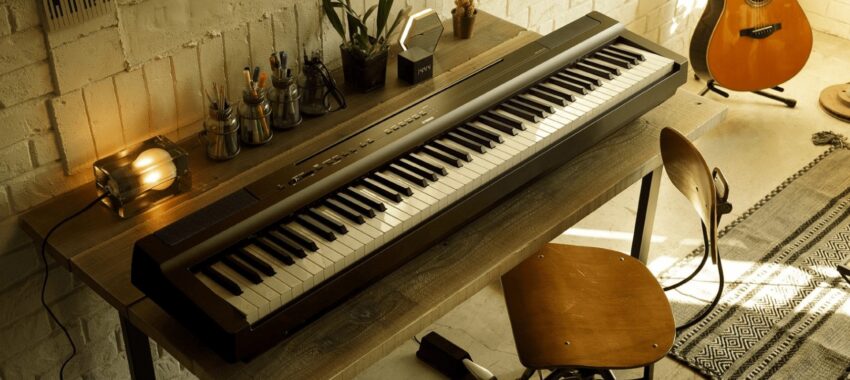In this article, we’re going to review the features of Yamaha P125 in detail and share my view of it.
Yamaha P125 is a new weighted digital piano from Yamaha ‘P’ series, which was released in 2018.
It inherits many powerful features from its predecessor Yamaha P115, one of the most popular digital pianos in the ‘P’ series. With several improvements in sound and features over its predecessor, Yamaha P125 has become a new excellent digital piano at a reasonable price.
Yamaha P125 combines incredible resonate sounds, portable design and other updated features that make it a solid mid-range option on the market.

An Overview of Yamaha P125 Digital Piano
Yamaha P125 Specs
- An 88-key fully-weighted hammer-action digital piano with resonant sound
- Weighted action: Yamaha’s GHS (Graded Hammer Standard)
- Sound: Pure CF sound engine
- Touch sensitivity: 3 levels and off (Fixed, Soft, Medium, Hard)
- Polyphony: 192 notes
- Voices: 24 instrument sounds
- Modes: Duo, Dual, Split
- Educational Features: Lesson Mode
- Recording Function: Built-in 2-track recorder
- Sound effects: 4 types of Reverb
- Metronome: Built-in Metronome
- Connections: USB to Host, sustain jack, 2 headphone jacks, line out jacks
- Speakers: 12 cm x 2 + 4 cm x 2
- Amplifiers: 7 W x 2
- Weight: 26 lbs
- Dimensions: 52″ wide x 11.6″ deep x 6″ high
- Accessories: AC Adaptor, A sustain pedal, Music Rest
General Review of Yamaha P125
Yamaha P125 is an 88-key fully weighted digital piano with compact and portable design, which is a perfect fit for players from entry-level to intermediate level and gigging musicians.
The main area it shines is the incredible high-quality sound. It proves a rich and spacious stereo sound thanks to the newly improved 2-way speaker system and the sound boost system. Additionally, Yamaha P125 is loaded with 192-note polyphony, which is definitely enough for you to play any pieces.
The manufacturer has created a free APP called Smart Pianist, which can be used as a remote controller to your digital piano. It allows you to avoid setting troubles, and you can easily get back to the default setting.
There are many other powerful features, including recording function, 24 instrument voices and several modes.
For beginners, Yamaha P125 is an ideal digital piano for you to start out, and it also provides advanced functionality that will grow with you as you get progressed. For players with the musical background, Yamaha P125 delivers high-quality resonate sound and weighted action for you to get inspired and get to higher levels.

Check the Latest Price on Amazon
Features of Yamaha P125
With your first impression in mind, let’s start taking a closer look at several main aspects of Yamaha P125 digital piano.
1. Sound Quality
When purchasing a digital piano, sound quality and key action are always the two most important factors which you need to take into consideration.
Sound quality is the most outstanding feature that Yamaha P125 offers. I was able to play this digital piano several times. As soon as I played the P125, the first thing that impressed me is the resonate stereo sound. It sounds like a real acoustic piano.
-
Sound Engine
Yamaha P125 is equipped with the Pure CF Sound Engine, which is Yamaha’s mid-range engine to recreates the sound of the famous Yamaha CFIIS concert grand piano.
The model uses four layers of grand piano sampling compared to the three layers of its predecessor P115. Every note was recorded at different velocity levels between soft and loud in the high end and low end. It allows you to play pieces with more expression and dynamics and get closer to playing on an acoustic piano.

-
Speakers
There is one thing that is really worth mentioning is that Yamaha P125 uses a newly improved 2-way speaker system. The digital piano is equipped with 4 speakers, which is not common on the digital pianos in this price range. There are two speakers on each side, including two 12 cm full-size speakers and two 4m speakers.
The speaker system is open to both upward and downward directions, offering remarkable boosted sound projected towards the players and audiences by creating the immersive sound.
The boosted sound quality makes the sound gorgeously resonate in the high registers and low registers. You’ll love the sound as soon as you hit the keys.
-
Polyphony
Additionally, the polyphony number contributes to the quality of the sound.
Polyphony number means the maximum number of notes a digital piano can produce simultaneously. It usually works with sustain pedal and sound effects. When you use sustain pedal, the notes need enough polyphony number to keep all the notes sounding as you continually add more notes.
Yamaha P125 is loaded with 192-note polyphony, which is above the average number of 128 notes on the digital pianos in this class.
The more polyphony number the digital piano offers, the most expressiveness you can get in your tunes. It helps you to be a more sensitive pianist. Considering about 192 notes, it’s definitely enough for you to play any music pieces. So, it’s not something that you should worry about.
-
Comparison
In terms of sound, compared with Casio PX 160 (Full review here) and Roland FP-30 (Full review here) which are another two popular models on the market, I think Yamaha P125 can be the one that wins over. Benefit from its 4-speaker system and 192-note polyphony, Yamaha P125 delivers a more authentic and brighter sound that is closer to an acoustic piano.

2. Keys
Yamaha P125 is equipped with GHS (Graded Hammer Standard) weighted action. It’s probably the most famous weighted action from Yamaha, which is marketed as an entry-level weighted action. And basically, this weighted action has been used in almost every digital piano under $1000.
Weighted action is that when you press the keys, there is some resistance responding to your finger and you can feel some natural weight.
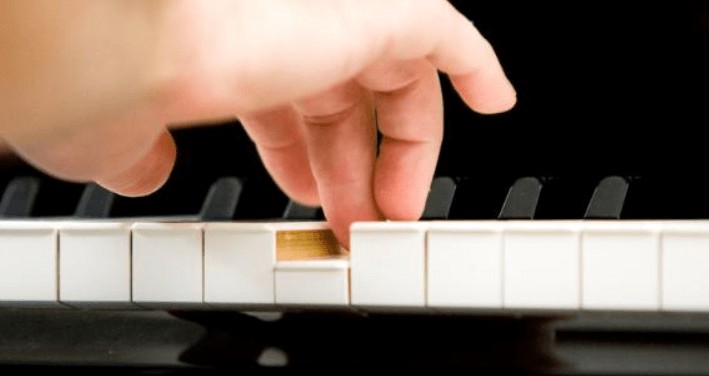
GHS is a hammer action weighted action that is designed to simulate the real feel of an acoustic piano. It allows you to have heavier touch in the low end and lighter touch in the high end.
Compared with the weighted actions of other models that are around $500, GHS is a bit less realistic to my view. However, it still provides correct response allowing you to practice finger techniques for the time when you play on a real piano.
Plus, the keys on Yamaha P125 do not come with simulated ivory and ebony key surfaces, but it has a matte finish on the top of the black keys. So, you can feel the smoother touch and avoid slipping off the keys while your hands are sweaty.
3. Design

Yamaha P125 is available in both black and white finish. It’s one of the best white digital pianos on the market.
And, Yamaha P125 is from the ‘P’ series which stands for portable. So, the digital piano comes with a very portable and compact design.
The dimension of Yamaha P125 is 52″ wide x 11.6″ deep x 6″ high. You can just put it on the table. It’s super great for those who want a digital piano without taking up too much space. Impressively, Yamaha P125 features a new ‘Table EQ’ feature which enables players to get optimal sounds when the digital piano is placed on a flat surface.
The weight of Yamaha P125 is only 26 pounds, which would perfectly fit for gigging musicians and those who travel a lot.
Plus, there is a lighter and more compact version of Yamaha P125, the Yamaha P121. They have the completely same features and design except for the number of keys: The P121 has 73 keys. This model could be a solid option for those who are looking for a more compact and portable digital piano.
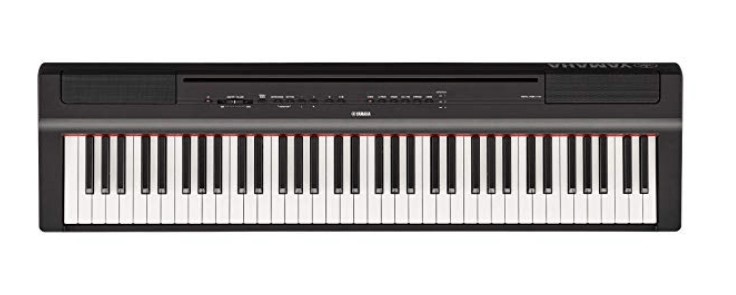
View Yamaha P121 73-key Digital Piano on Amazon
4. Free Smart Pianist App
There is one thing that often happens in digital pianos and keyboards. If there are too many buttons, you are easy to get lost with which settings you are using. Sometimes it’s difficult to get back to the default setting, which could be very annoying.
In this case, Yamaha has created a free App called Smart Pianist for being user-friendly to all players.
The App can be used as a remote controller to your digital piano. It has a clean interface allowing you to select voices, rhythms, and modes, etc. Basically, you can get access to the whole features of your digital piano. Therefore, you can get rid of getting lost of the settings and easy to get back to the default.
Additionally, there is a powerful function that we rarely see in other apps. You choose your favorite songs from your smart devices and Smart Pianist is able to analyze the songs then come up with the chords or the scores for you to play along with.
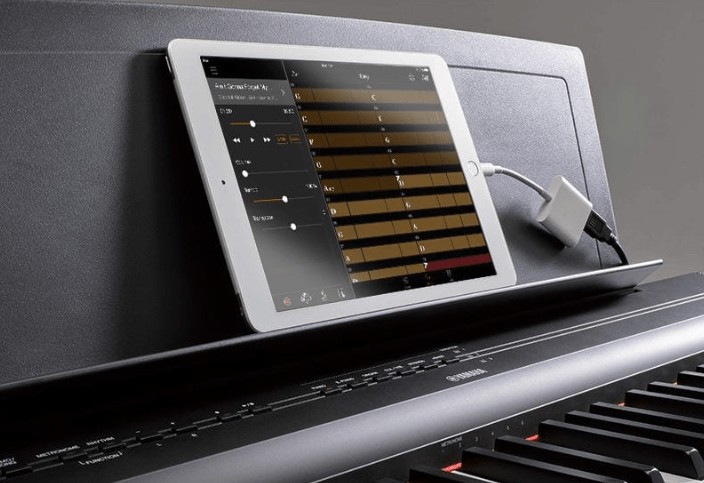
5. 2-track MIDI Recorder
The P125 features internal recording function. The recording button and a Play/Stop button are on the board. You do not need to record by connecting to other devices.
It’s a very useful feature while practicing, you can record your performance and playback to see how well your practice is going. After you recorded, you can transfer the audios to your computer and compare it with subsequent recordings.
Additionally, Yamaha P128 is equipped with a 2-track recorder. It allows you to record 2 tracks separately and then play them back together as one song. Plus, you can also practice your two hands individually by using this function. Specifically, you can record one track of your right-hand part first, and then play the left-hand part while listening to the playback of the other track.
Additional Features
-
Voices & Rhythms
Yamaha P125 is loaded with 24 instrument voices, including:
- 4 Grand Pianos (Grand, Live, Ballad, Bright)
- 4 Electric Pianos (Stage, DX, Vintage, Synth)
- 2 Clavichords
- 4 Organs (Jazz, Rock, Organ Principle, Organ Tutti)
- 2 Vibraphones
- 4 Strings (Strings, Slow Strings, Choir, Synth Pad)
- 4 Bass (Acoustic, Electric, Bass & Cymbal, Fretless Bass)
The digital piano also comes with 20 rhythms, 21 demo songs, and 50 piano songs for you to choose.
-
Sound Effects
The sound effects on Yamaha P128 are not that many. They are for you to customize your tones.
The digital piano comes with 4 types of Reverb, allowing you to make your notes more resonate and you can adjust its depth within the 0-20 range.
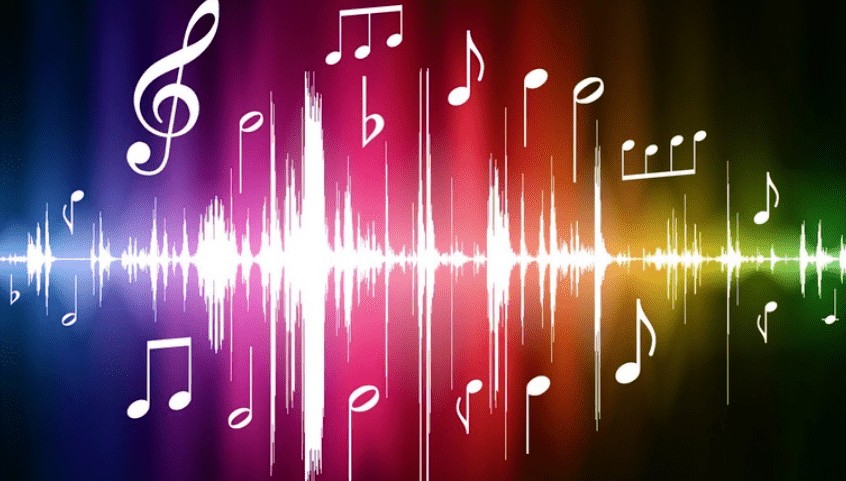
Things You Need to Pay Attention to
No Bluetooth Connectivity
Some digital pianos on the market in this price range come with Bluetooth Connectivity (For example, Roland FP-30). It allows you to connect other devices wirelessly.
Yamaha P125 lacks this function. However, Smart Pianist App allows you to get access to almost all the features of the digital piano. It makes the operation less difficult, right?
Yamaha P125 vs Yamaha P115
Yamaha P125 is the successor of the P115 with the improvement of weak areas of its predecessor and some new features.
The main biggest improvement would be the speaker system. Yamaha P125 uses an improved 2-way speaker system offering more expressive and dynamics sound in contrast with the weak speaker system Yamaha P115 uses. In my view, Yamaha P125 seems to have brighter and crisper sound than the P115.
Well, Yamaha P115 is still a solid option on the market, but the P125 is getting more and more popular among beginners and intermediate players for its incredible sound and versatile features.
Yamaha P125 Review
Yamaha P125 Overall Score: 8.2/10
Brilliant features
- Super high-quality stereo sound
- Built-in recording function (2-track recorder)
- 192 polyphony notes
- Portable and compact
- Free Smart Pianist App
- 24 instrument voices
Watch out for
- Lack of Bluetooth connectivity
- Non-textured keys
Final Words
Yamaha P125 is well worth considering, concerning the useful features it comes with.
It’s a great digital piano for beginners and intermediate players to enjoy. The model stands out for its impressive resonate sound, proper weighted action, and other versatile functions, allowing you to have endless enjoyment and portable design can let you take it anywhere you want.
The P125 can be a long-term investment, giving you high-quality playing experiences and offering more room for you to grow in your piano journey.
Check the Latest Price on Amazon

